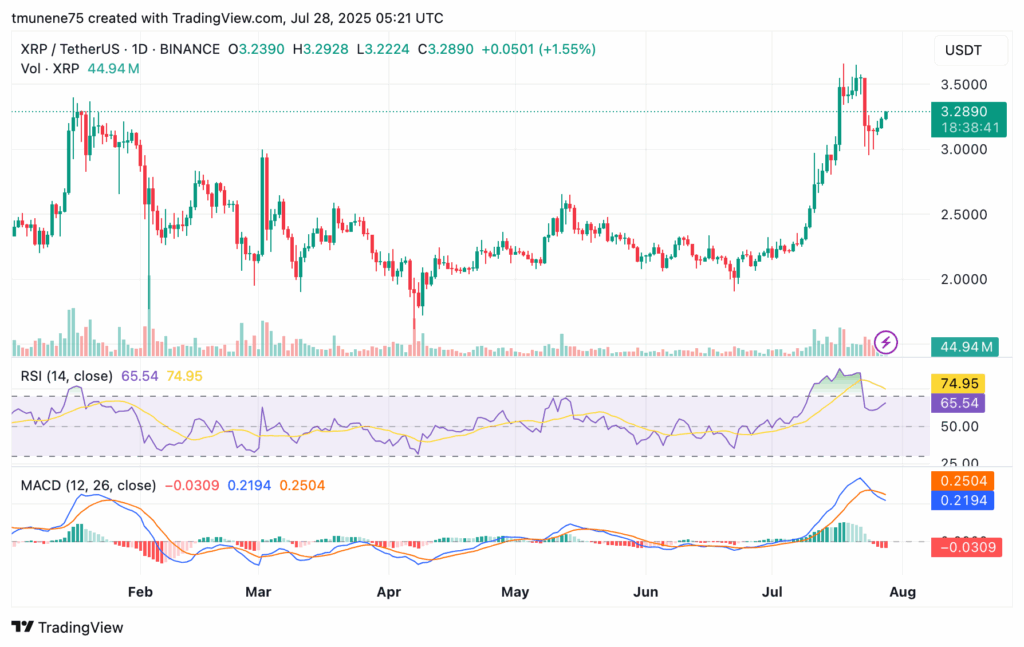XRP is holding above the critical $2.47 support level after a significant breakout, with rising volume and bullish patterns indicating potential price targets at $4.80 and $7.13 in the near term.
-
XRP broke a long-term downtrend and now targets $4.80 and $7.13 after maintaining key support at $2.47.
-
Rising trading volume and a rounded bottom breakout from a 2018 wedge confirm the strength of XRP’s bullish momentum.
-
RSI remains bullish above 50 despite a short-term MACD slowdown; $3.00–$4.00 levels are critical for near-term price action.
XRP holds above $2.47 after a major breakout, with bullish volume and technical patterns pointing to $4.80 and $7.13 targets. Stay informed with COINOTAG.
How Did XRP Break Out of Its Multi-Year Downtrend?
XRP broke out of a multi-year downtrend by holding above the crucial $2.47 level, signaling a shift in market sentiment. This breakout follows a long accumulation phase between $0.30 and $0.90 from 2021 to 2023. The breakout was confirmed by rising volume and a rounded bottom pattern, indicating strong buyer interest and a structural trend reversal.
What Technical Patterns Support XRP’s Bullish Trend?
The breakout emerged from a falling wedge pattern dating back to 2018, coupled with a rounded bottom recovery. This combination is a classic bullish reversal signal. Volume surged to 45.02 million during the rally, confirming active market participation. The RSI remains above 50, maintaining a bullish bias, while the MACD shows a short-term slowdown, suggesting possible consolidation before further gains.

What Are the Key Price Levels and Indicators for XRP’s Near-Term Movement?
XRP’s price action between mid-June and late July shows a rise from below $2.00 to a peak near $3.50, followed by a correction to around $3.00. Current trading hovers near $3.29. Resistance is seen at $3.50 and the $3.75–$4.00 range, while support holds at $3.00 and $2.60–$2.80. These levels will guide short-term momentum and consolidation phases.
How Do RSI and MACD Affect XRP’s Momentum Outlook?
The RSI cooled from 74.95 to 65.54 but remains above 50, signaling sustained bullish momentum. Conversely, the MACD recently formed a bearish crossover, indicating a potential short-term slowdown or consolidation. Traders should watch these indicators closely to gauge momentum shifts.

What Are XRP’s Upside Targets and Market Outlook?
As long as XRP holds above $3.00, the bullish trend remains intact. The next resistance zone lies between $3.75 and $4.00, with a technical target at $4.80 representing a potential 44% gain. Should momentum continue, $7.13 emerges as a longer-term target based on historical pattern projections and volume support.
| Price Level | Value | Significance |
|---|---|---|
| Support | $2.47 | Key breakout retest zone |
| Near-term Resistance | $3.50 – $4.00 | Consolidation and breakout zone |
| Target 1 | $4.80 | Technical upside target |
| Target 2 | $7.13 | Long-term projection |
Frequently Asked Questions
What technical patterns support XRP’s bullish trend?
XRP’s bullish trend is supported by a rounded bottom breakout from a falling wedge pattern dating back to 2018, confirmed by rising trading volume and sustained RSI above 50.
How does XRP’s current momentum affect its price outlook?
Despite a short-term MACD slowdown, XRP’s momentum remains bullish with RSI above 50, suggesting potential for further price gains toward $4.80 and beyond.
Key Takeaways
- XRP’s breakout above $2.47 marks a significant trend reversal after years of accumulation.
- Rising volume and bullish RSI confirm strong market participation and momentum.
- Price targets at $4.80 and $7.13 highlight potential upside based on technical analysis.
Conclusion
XRP’s sustained support above $2.47 and breakout from a long-term downtrend signal a strong bullish trajectory. With volume and momentum indicators supporting further gains, key resistance levels between $3.50 and $4.00 will guide near-term price action. Investors should watch for confirmation of these targets as XRP aims for $4.80 and potentially $7.13, reflecting a robust recovery phase.
